Static mixers for mineral extraction processes
The static mixer heat exchanger prevents large temperature differences in the product
Cooling and heating viscous products is usually difficult in comparison to watery products. This is primarily because forced convection is missing, the flow patterns are in the laminar area and therefore adequate replenishment of product to the heat exchanging surface fails. This can lead to large temperature differences in the product and can have a negative effect on the quality of the end product.
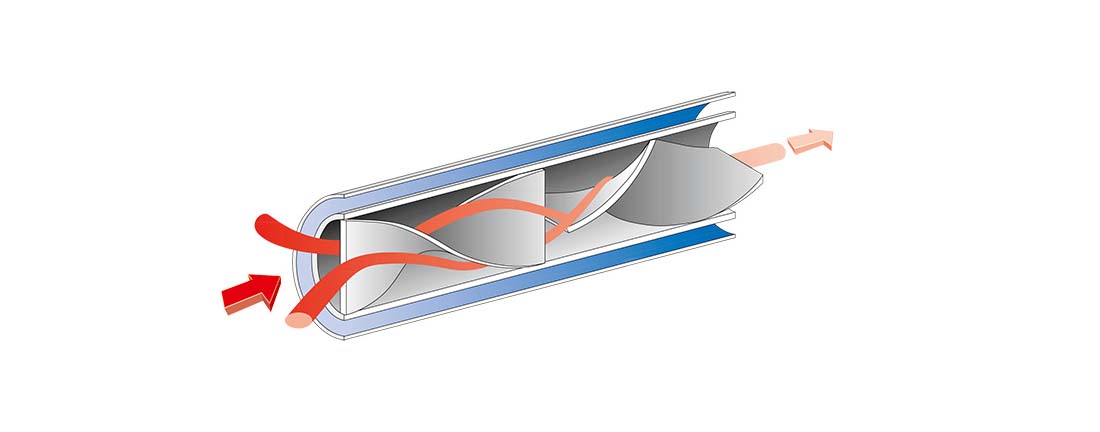
Heat exchanger according to the basic principles of the static mixer
Because static mixers purposefully disturb the flow patterns in a tube, it is possible to improve the heat transfer with static mixers when cooling and/or heating. This principle was the basis of the development of the type of heat exchanger that PRIMIX manufactures.
Heat exchanger construction
The PRIMIX inline heat exchanger consists of single or multiple parallel mounted pipes. The heat-exchanging medium flows around these pipes; that can be either cold or hot water, as well as hot oil or steam. The viscous product flows through the heat exchanger tubes and exchanges its heat on the colder or warmer surface of the tube. The spiral-shaped mixing elements which are placed in these heat exchanger tubes disrupt the laminar flow pattern, allowing a better renewal rate of product on the heat-exchanging surface and thus a more efficient cooling or warming-up process.
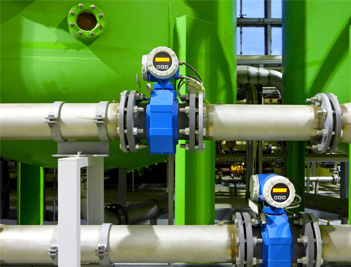
With ACT 20% - 100% more heat transfer
The Advanced Connection Technology (ACT) used in the PRIMIX heat exchangers, results in additional contact surface and a 20% to 100% better heat transfer. With this technique, the mixing elements are seamlessly soldered into the tube. The slit, which is located between the spiral shaped element and the inner wall of the tube, gets completely filled with soldering material. By ensuring optimal conditions during this soldering process this connection between tube and element works as a heat conductor. As a result, the surface of a mixing element also gets involved in the process of heat exchange, resulting in a more compact and efficient design of the heat exchanger.
Minimisation of the residence time spread in the heat exchanger
In the design of the heat exchanger minimisation of the residence time spread is achieved by the optional use of dedicated adapters with razor-sharp edges. The flat inflow surface of the pipe sheet has thus been completely concealed resulting in a significant improvement in the flow pattern. The design is used as standard for viscous and responsive liquids where minimization of the residence time spread is important. Further minimization of the residence time spread is achieved by providing the heat exchanger elements with very smooth surfaces in places where the product to be cooled comes in contact with the heat exchanger surface. The reliability of the PRIMIX constructed static mixer heat exchanger has proven itself in crucial applications in the chemical, petrochemical, pharmaceutical and food industries. Explosive and toxic process media are reliably mixed and thermally treated in this way.
Laminar flow heat exchanger – motionless mixer system
The viscosity of the flowing product has great influence on the flow pattern through the empty tube. This flow pattern is mostly laminar and really not turbulent. A laminar or layering flow pattern means that, in theory, liquid in the centre of the tube flows the fastest and the liquid closest to the tube wall is stationary. The in between layers of liquid behave like circles of equal flow; they are the flow layers or laminar flow pattern. With a motionless mixer system or static mixer this flow pattern is broken. Liquid on the inside tube wall is folded in and the liquid in the middle flows towards the tube wall again, allowing more liquid to come into contact with the inner wall. In a pipe heat exchanger, this inside tube wall is used to exchange heat; the static mixer improves this process significantly.
Mixing principles of a spiral shaped (helical) mixer element
Mixing gases and liquids without moving parts takes place in continuous or semi batch processes within the chemical, process, food and pharmaceutical industry. The standard well-known laminar or turbulent flow patterns are disturbed deliberately by means of a number of elements placed in the flow.
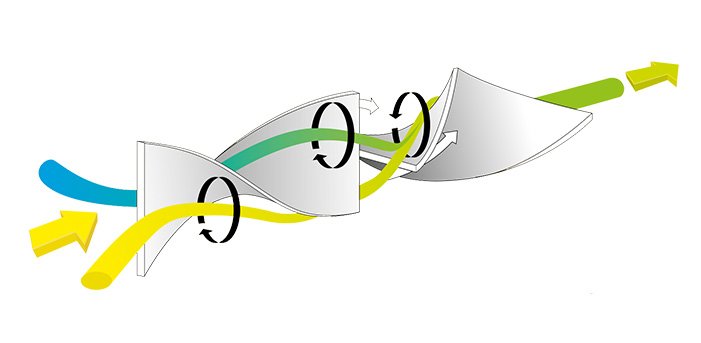
This modified flow of gases and/or liquids has been controlled in such a way, particularly by the form and manner of placement of the helical mixing elements, that we can determine the degree of mixing in advance. The degree of mixing is expressed with the term homogeneity. Of course there are no moving parts in static mixers.
 String of mixer elements determines the flow pattern within a static mixer
String of mixer elements determines the flow pattern within a static mixer
The type of mixer elements inside a static mixer have a number of corresponding characteristics. There are a minimum of two elements in a static mixer and they are placed one behind the other as a string. The mixing elements strand which is constructed like that gives an axial twist to the flow pattern, and each successive element has alternately a left and a right-hand twist. In addition each subsequent element is placed rotated by 90 degrees in comparison with its predecessor.
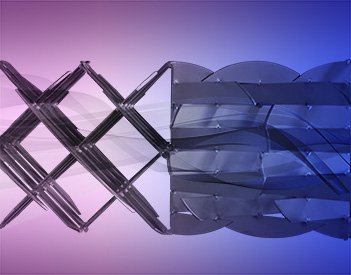
Static mixing with laminar flow
Following the laminar principle, the flow is repeatedly split into sub flows in a static mixer and subsequently brought together again. With the right pitch a balanced flow is created from outside to the inside and vice versa. This is how the medium is mixed, in a large amount of very thin layers, and the number of layers created determines the extent of the mixing.
Static mixing with turbulent flow
The mixing effect of a static mixer following the turbulent mixing principle is mainly achieved by internal rotation and shearing away the layers within the liquid. This happens at the point where the direction of the rotation is reversed. When small percentages of shearing are required then the pitch between two rotations can be accurately adjusted to achieve this. With this pitch the rotation process is slowed down which results in extra mixing. After this reversed rotation will also start more slowly.
Homogeneity of the mixture
The homogeneity of the mixture is best measured by determining the temperature deviations or the concentration differences behind the PRIMIX static mixer. This is expressed in the theory of probability as standard deviation measured against the average. In the diagram below it is clearly visible when the medium is homogeneous.
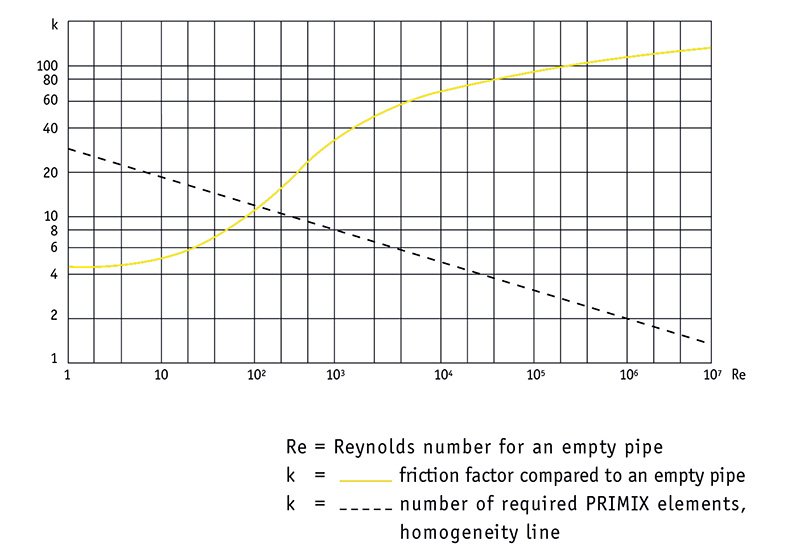
Pressure drop across the static mixer
When determining the pressure drop across the PRIMIX static mixer a friction factor is used. This factor gives information about the pressure drop in relation to an empty pipe. Just as for the homogeneity we also made a diagram for this, so that with the help of the pressure drop across an empty pipe the pressure drop across a static mixer can also simply be determined. For the choice of culvert both the pressure fall and the length determine the homogeneity.
Dispersion inside the static mixer
In the PRIMIX static mixer dispersions and emulsions can form on the interface of the two elements, where the rotation direction changes. The surface tension is broken and the diffusion of one phase into the other can take place. With a decreasing diameter and an increasing speed, the particle size becomes smaller.
Also check out our news article on how a static mixer works.

 English
English  Deutsch
Deutsch  Español
Español  Français
Français  Nederlands
Nederlands